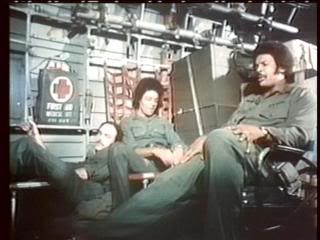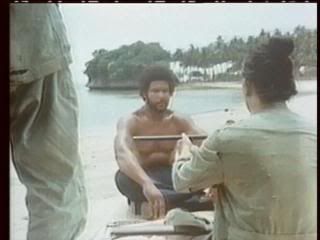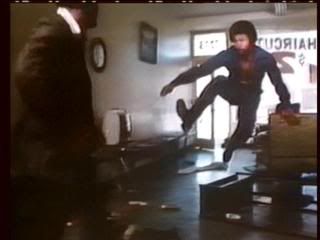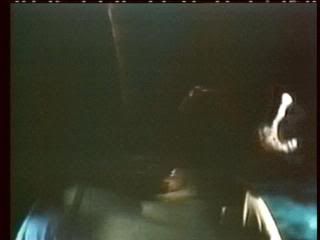Cirio H. Santiago directed or produced a number of blaxploitation/kung-fu hybrid films in the mid-1970s (including TNT Jackson and Bamboo Gods and Iron Men) - usually made in the Philippines - but the genre mashing only held so much potential, so during the tail end of the decade he brought together the equally odd pairing of blaxploitation elements with samurai films in his film Fighting Mad (originally titled Death Force). Santiago had a rather keen eye for bringing together disparate elements into something entertaining despite working with low budgets - this one often looks even cheaper than his earlier efforts - and despite taking a little time to get going, Fighting Mad is no exception.
It's actually a rather imaginative concept: Three soldiers return from Vietnam with a slew of smuggled gold bricks. Doug Russell (James Iglehart) dreams of returning to his wife and newly born child, but his partners (including Penitentiary's Leon Isaac) are more interested in running a criminal empire, so on the boat ride back to the States they slit his throat and throw him overboard. Doug washes up on an island inhabited only by two WWII Japanese soldiers who refuse to believe that the war has ended, but grudgingly accept him and - after the usual period of humbling - train him in the art of the Samurai. After hitching a ride back to the U.S. with some visiting soldiers (who don't seem too concerned about being attacked by Doug and his Japanese pal), Russell tracks down his wife (Jayne Kennedy) before taking on the mafia with only his wits and razor sharp samurai sword. Expect a surprising number of decapitations before everyone lives happily ever after.
Cited by Quentin Tarantino as a major influence, Santiago is an exploitation film legend and films like Fighting Mad go a long way to confirming his talents. Far from high art, the film still delivers a great deal of high energy, popcorn fun with the requisite squeaky clean heroes, dastardly villains, and smatterings of gore and/or nudity with the trademark international elements unique to his productions. The Philippines is not always the most convincing double for California, but production values are generally quite high and some strong casting - particularly James Iglehart, who really did make a terrific, charismatic leading man - goes a long way towards keeping things from getting bogged down. While the actual martial arts action doesn't compare to the Chinese or Japanese efforts of the time, it has its own sloppy charm that is certainly never boring.
Santiago doesn't bring much visual flair to the proceedings, but once Phillips arrives on the island - and the film begins cross-cutting between his samurai education and the rise of his criminal antagonists - the pace picks up as well, speeding up considerably once Doug reaches the U.S. and starts taking care of business. A fight between Doug and a hired goon in a barber shop, in particular, shows off some fine orchestrated destruction that is a lot of fun because of its lack of polish, and the finale get appropriately bloody once Doug's family are (of course) kidnapped and he has to go to Mexico to get them back.
Leon Isaac is appropriately dickish as the main baddie, though it's a tad uncomfortable to watch him beat and attempt to rape Jayne Kennedy, his future wife. Jayne gets to sing a few songs (which slow things to a halt), but doesn't have a lot to do here. The two Japanese soldiers are quite good, adding a few moments of (fairly stereotypical) comic relief - particularly in a conversation regarding the term "mother humpers" - and an air of legitimacy once the three bond and start seriously training. Strangely, the entire film is rather badly dubbed, though it appears that most of the actors are speaking with their actual voices. I don't recall the dubbing being quite so obvious in some of Santiago's earlier films.
Sex and violence and surprisingly subdued for much of the film, besides some messy gun-fights, but things break out in the last ten minutes as Phillips starts lopping off heads left and right - with appropriately messy arterial spray included. There's a brief sex scene - as well as the mentioned attempted rape - but no nudity, and certainly nothing quite as obviously wonderfully exploitive as the topless fight scene in TNT Jackson. Music is by genre mainstay Jaime Mendoza-Nava (The Town That Dreaded Sundown, Vampire Hookers), but is fairly forgettable.
Part of the Millcreek 50 Kung-Fu film collection, Fighting Mad is presented in a muddy, full-frame transfer that is likely comparable to the film's (many) VHS releases. Somehow a number of Santiago's films fell into the public domain, so it's unfortunately unlikely that we will see a cleaned up version of the movie in its original aspect ratio any time soon. The few night scenes are a little dark and murky, but things are generally soft, but quite watchable.
As per usual in this collection, all we get is four chapter stops. Fun!
A silly but fun revenge action film, Fighting Mad holds up its end of the bargain by delivering all the promised amounts of action and bloodshed, and doesn't overstay its welcome. A novel concept, strong performances, and a director with a strong grasp of what his audience wants - and a willingness to deliver - makes this one a pleasant surprise, and definitely worth checking out.
In fact, why not do that right now?















No comments:
Post a Comment